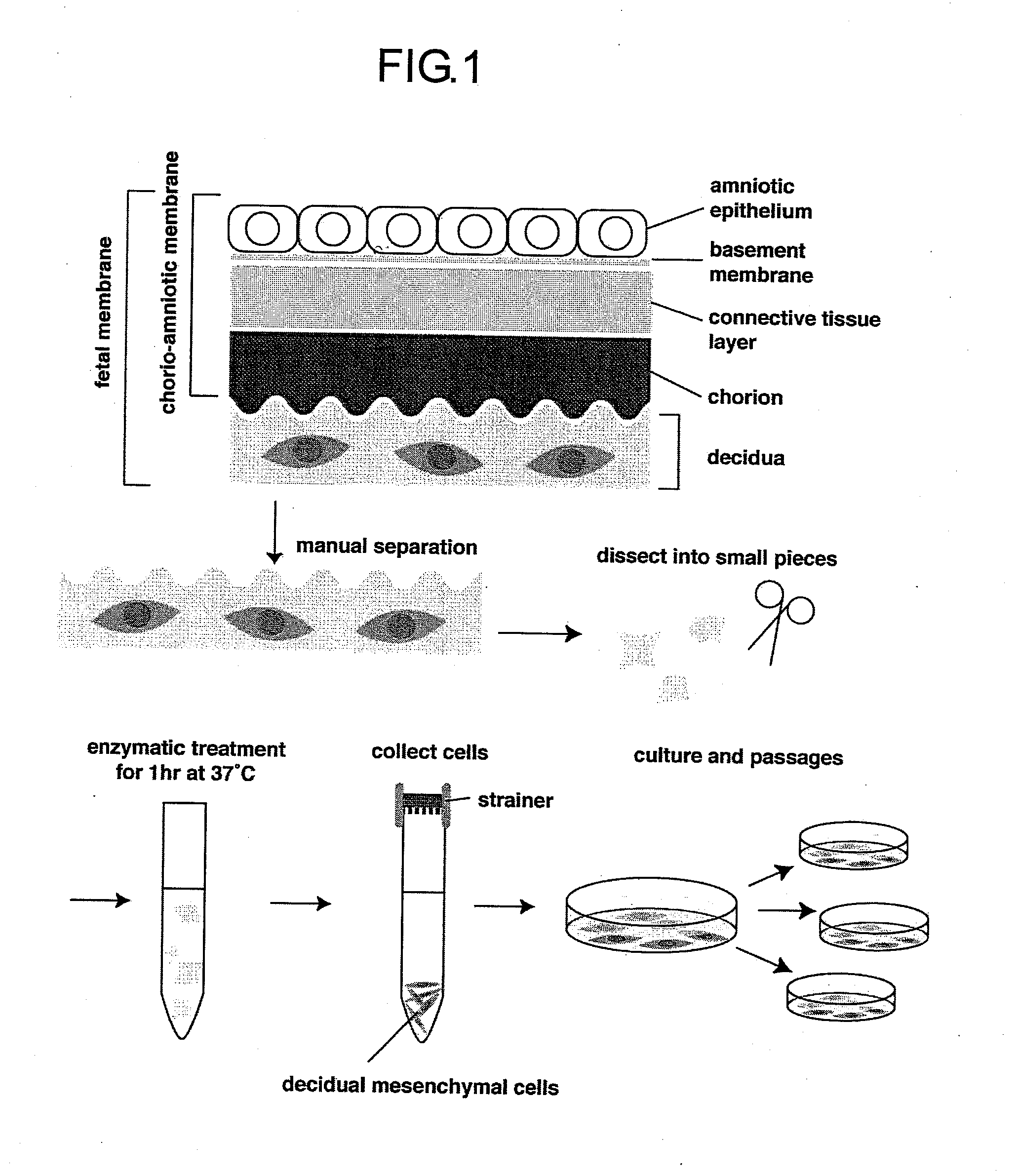Method of culturing pluripotent stem cells using extracellular matrix from fetal membrane-derived cells
a technology of fetal membrane and stem cells, applied in the field of new methods of culturing pluripotent stem cells, can solve the problems of difficult to obtain human tissue, small amount of tissue obtained, difficult routine use, etc., and achieves the effect of large quantity, safe and efficient operation, and sufficient quantitative supplies
- Summary
- Abstract
- Description
- Claims
- Application Information
AI Technical Summary
Benefits of technology
Problems solved by technology
Method used
Image
Examples
example 1
Maintenance Culture of Human ES Cells on Mesenchymal cells of maternal origin from human fetal membrane (decidua)
1. Preparation of Decidua-Derived Mesenchymal Cells (DMC)
[0062]Complying with informed consent previously obtained from a mother, the human fetal membrane of placenta accessory tissue during delivery was obtained, and the tissue of the decidual portion was manually recovered therefrom. The human decidual tissue was dissected with scissors, after which it was warmed at 37° C. in a solution comprising PBS supplemented with 0.1% collagenase I solution, 0.01% DNase I, and 0.1% dispase (all manufactured by Invitrogen / Gibco-BRL), using a constant-temperature chamber equipped with a shaker for 60 minutes, and the cells were separated and cultured. The cells recovered were identified as mesenchymal cells by examination of their morphology (FIG. 2), and by actin staining with phalloidin and vimentin immunostaining with anti-vimentin antibody. Negativity for HLA-G, which is a marke...
example 2
Maintenance Culture of Human ES Cells on Extracellular Matrix Extracted from Human Decidua-Derived Mesenchymal Cells
(Methods)
[0069]Human decidua-derived mesenchymal cells were prepared as described in Example 1. The human decidua-derived mesenchymal cells were seeded to a plastic culture dish coated with 0.1% gelatin at a density of 3.5×104 cells / cm2, and cultured for 3 days while a confluent state was maintained. After washing with PBS, the cultured cells were treated with deoxycholic acid (treatment with 0.5% sodium deoxycholate / 10 mM Tris-HCl, pH 8.0, added to the culture dish, at 4° C. for 30 minutes) to lyse the cell components. The extracellular matrix components remaining on the culture dish were washed with PBS. For culturing the human decidua-derived mesenchymal cells, a D-MEM-F12 medium supplemented with 10% fetal bovine serum, or a D-MEM-F12 medium supplemented with N2 supplement (Invitrogen)+20 ng / ml human recombinant FGF-2 (Peprotech)+20 ng / ml human recombinant EGF (Pep...
example 3
Maintenance Culture of Human ES Cells on Extracellular Matrix from Human Decidua-Derived Mesenchymal Cells Using Chemically Synthetic Medium
(Methods)
[0078]Preparation of an extracellular matrix from human decidua-derived mesenchymal cells and maintenance culture of human ES cells were performed in the same manner as Example 2 except for the culture broth. In place of the MEF culture supernatant, the STEMPRO hESC SFM culture broth (Invitrogen Co.), a chemically synthetic medium, was used as the culture broth.
[0079]Further more, maintenance culture of human ES cells was performed in the same manner using culture dishes coated with an extracellular matrix from human decidua-derived mesenchymal cells, stored in a refrigerator (4° C.) for 3 weeks and 8 months.
(Results)
[0080]In the culture on the extracellular matrix from human decidua-derived mesenchymal cells using the STEMPRO hESC SFM culture broth, human ES cells proliferated well, and the cell count increased 34,000,000 folds compare...
PUM
| Property | Measurement | Unit |
|---|---|---|
| time | aaaaa | aaaaa |
| temperature | aaaaa | aaaaa |
| temperature | aaaaa | aaaaa |
Abstract
Description
Claims
Application Information
 Login to View More
Login to View More - R&D
- Intellectual Property
- Life Sciences
- Materials
- Tech Scout
- Unparalleled Data Quality
- Higher Quality Content
- 60% Fewer Hallucinations
Browse by: Latest US Patents, China's latest patents, Technical Efficacy Thesaurus, Application Domain, Technology Topic, Popular Technical Reports.
© 2025 PatSnap. All rights reserved.Legal|Privacy policy|Modern Slavery Act Transparency Statement|Sitemap|About US| Contact US: help@patsnap.com



